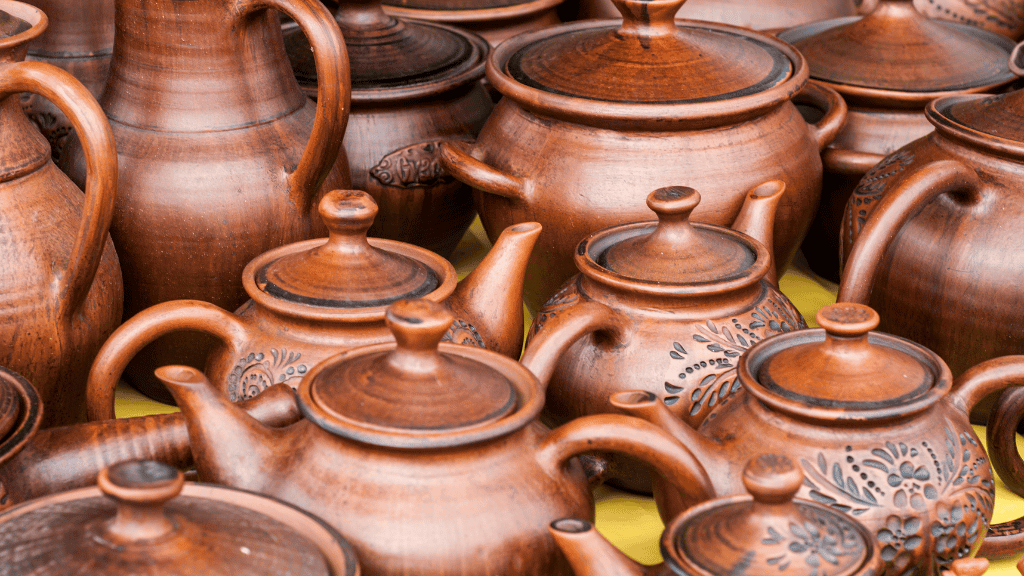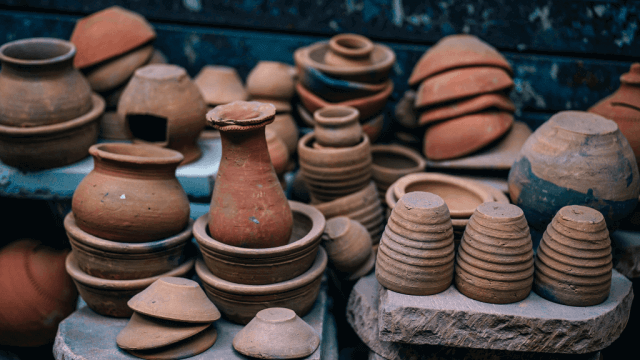Stoneware pottery is a type of ceramic ware made from clay that is fired at high temperatures (typically between 1200°C and 1300°C) and often glazed.
This process results in a vitrified and dense structure, giving it durability, water resistance, and resistance to wear and tear.
Stoneware is favored for its functionality, versatility, and natural, rustic appearance.
Defining Stoneware Pottery
Stoneware pottery is a popular type of ceramic ware characterized by its dense, vitrified structure and resistance to water, wear, and tear.
It is made from a specific clay composition and fired at high temperatures, generally ranging from 1200°C to 1300°C.
Due to its durability, stoneware has significant practical applications and a rustic, natural appearance that appeals to many artists and collectors.
Key Characteristics of Stoneware
Vitrified Structure
Stoneware is known for its vitreous or glass-like structure, which gives it an inherent strength and resistance to chipping and cracking.
This is a result of high-temperature firing, which fuses the clay particles, filling in the pores and making it impermeable to liquid.
Water Resistance
Due to its dense and vitrified nature, stoneware has a low porosity, making it highly resistant to liquid penetration.
This water resistance makes it suitable for functional ware such as dishware, serving bowls, and storage containers.
Durability
Stoneware’s rugged composition and high firing temperatures give it exceptional durability.
The material is designed to withstand daily use, making it a popular choice for cookware and tableware that can endure exposure to different temperatures and handling.
Stoneware Glazing Techniques
Most stoneware pottery is glazed to provide a decorative and functional element.
Glazes serve as an additional protective layer against moisture and enhance the artwork.
Some popular glazing methods include:
Oxide Glazes
These glazes utilize metallic oxides to create unique color effects and finishes.
They can produce a wide range of hues and textures, from matte to glossy surfaces.
Celadon Glazes
Celadon glazes are a type of traditional Asian glaze that provides stoneware with a distinct pale green or blue hue.
They have been used for centuries to create elegant, sophisticated pieces.
Slip Glazing
Slip glazing involves applying a thin layer of liquid clay, or slip, to the surface of the stoneware prior to firing.
This technique can create a range of textures and colors, depending on the type of clay used and the slip’s thickness.
Historical Background of Stoneware Pottery
Stoneware pottery has a rich history, dating back thousands of years.
Originating in Ancient China around 1400 BCE, stoneware production soon spread across the globe, with cultures from Europe, Africa, and the Americas eventually adopting this durable ceramic material.
Many archaeological investigations have uncovered stoneware artifacts, providing insight into the everyday lives and artistic expressions of various ancient societies.
The Stoneware Firing Process
One of the defining features of stoneware pottery is its firing process, which requires a high level of control over time and temperature.
The firing typically consists of two steps:
Bisque Firing
During the bisque firing, also known as the initial firing, stoneware pieces are slowly heated to remove any residual moisture.
This step strengthens the pottery and prepares it for glazing.
Glaze Firing
After the bisque firing, glazes are applied to the pottery and then fired once again.
This process is called the glaze firing, during which the glaze melts and fuses with the stoneware surface, creating a smooth, durable, and often colorful finish.
Types of Stoneware Clay
Stoneware can be crafted from a variety of clay types, offering versatility to potters and ceramic artists.
Some common stoneware clay varieties include:
Buff Stoneware
Buff stoneware clay features a combination of light-colored fire clays and white kaolin, which results in pottery with a warm, neutral tone.
This versatile clay is suitable for both wheel throwing and hand-building techniques.
Iron-Spotted Stoneware
Iron-spotted stoneware contains iron in its clay composition, which creates unique speckled patterns on the pottery’s surface during the firing process.
These markings add visual interest and can enhance a piece’s organic aesthetic.
Porcelain Stoneware
Porcelain stoneware is a blend of stoneware and porcelain clays, offering the strength of stoneware with the translucency and refined appearance of porcelain.
This type of clay is popular among artists who seek a delicate yet durable medium for their work.
Stoneware Pottery Uses
Due to its durability and versatility, stoneware pottery is used for a wide range of applications, from artistic expression to functional household items.
Some common uses include:
- Kitchenware: Plates, bowls, mugs, and serving dishes
- Home décor: Vases, sculptures, and decorative accents
- Garden ornaments: Planters, statues, and birdbaths
- Architectural components: Tiles, bricks, and fireplace surrounds
Whether chosen for its practical qualities or artistic potential, stoneware pottery remains an enduring and beloved form of ceramic art.
FAQ Section: Stoneware Pottery
Explore the most frequently asked questions about stoneware pottery, covering various aspects such as its properties, firing process, and applications.
The following FAQ section provides concise and informative answers to address any potential inquiries related to stoneware pottery.
What is the primary difference between stoneware and earthenware?
Stoneware is fired at higher temperatures (typically between 1200°C and 1300°C), resulting in a dense, vitrified, and sturdy structure.
Earthenware, on the other hand, is fired at lower temperatures (usually between 1000°C and 1150°C) and has a more porous and less durable structure, making it susceptible to chipping and moisture absorption.
Is stoneware pottery safe to use in ovens and microwaves?
Yes, stoneware pottery is generally considered safe for use in ovens and microwaves due to its durability and high resistance to thermal shock.
However, it is essential to ensure that the specific piece of stoneware is labeled “oven-safe” or “microwave-safe,” as individual glazes or decorations may react differently to heat.
How do I clean and maintain my stoneware pottery?
To clean stoneware pottery, simply wash it with warm soapy water and a soft sponge or cloth.
Avoid using abrasive scrubbers or steel wool, as they may scratch the surface.
Dry the pottery thoroughly before storing it.
Most stoneware is dishwasher safe, but it’s advisable to consult the manufacturer’s recommendations for any specific care instructions.
Why do some stoneware pieces have a gritty or sandy texture?
The gritty or sandy texture on certain stoneware pieces is due to the presence of grog, which consists of ground-up fired clay particles added to the clay body.
Grog helps in reducing shrinkage during drying and firing, preventing warping and cracking.
Its texture also gives stoneware pieces an earthy, organic appearance that many people find appealing.
Can I use stoneware pottery for food preparation and storage?
Yes, stoneware pottery is an excellent choice for food preparation and storage due to its low porosity, which makes it resistant to moisture absorption.
Stoneware is suitable for serving dishes, cooking pots, and storage containers.
However, ensure that your stoneware is food-safe and not coated with harmful glazes or chemicals before using it for culinary purposes.











